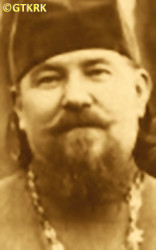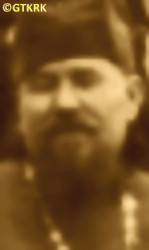Roman Catholic
St Sigismund parish
05-507 Słomczyn
85 Wiślana Str.
Konstancin deanery
Warsaw archdiocese, Poland
full list:
displayClick to display full list

searchClick to search full list by categories
wyświetlKliknij by wyświetlić pełną listę po polsku

szukajKliknij by przeszukać listę wg kategorii po polsku

Martyrology of the clergy — Poland
XX century (1914 – 1989)
personal data
surname
KUC
surname
versions/aliases
KUĆ
forename(s)
Andrew (pl. Andrzej)

function
presbiter (i.e. iereus)
creed
Eastern Orthodox Church ORmore on
en.wikipedia.org
[access: 2014.09.21]
diocese / province
Grodno‐Novogrod OR eparchy (Polish Autocephalous Orthodox Church)more on
drevo-info.ru
[access: 2020.09.24]
academic distinctions
Sacred Orthodox Theology Candidate
date and place
of death
20.09.1939

Vyalikiya Shylavichytoday: Derevyanchitsy ssov., Slonim dist., Grodno reg., Belarus
more on
be.wikipedia.org
[access: 2024.01.26]
alt. dates and places
of death
09.1939
details of death
During World War I soldier of the Imperial Russian Army.
After the German and Russian attack on Poland in 09.1939 and the start of World War II, after the beginning of the Russian invasion on 17.09.1939, the remnants of Polish troops left the garrison in nearby Baranavichy — moving towards the mobilization sites — on c. 18.09.1939.
Revolted Belarusians and Jews — communist activists, but not only them – immediately revealed themselves, waiting for the arrival of the Russian occupier: in some villages they began to erect welcoming gates and set up barricades on the roads, restricting the movement of both Polish troops and civilians.
Two days later in the morning, so on c. 20.09.1939, prob. after the Russian occupation began, five drunken local atheist communists broke into his farm and started „confiscating property”, i.e. robbery. Cattle, agricultural tools, and a warehouse were stolen.
Then tide him up and forced to watch helplessly as his wife was attacked — her arms were twisted and she was dragged along the corridor being stabbed with a sharpened stick in the process. Until died.
His turn came. Had eyes gouged out, tongue torn out, nose and ears cut off...
The naked, battered corpses were thrown into a horse–drawn cart, on which the bodies of three other people were already lying, and taken outside the village.
There, on the swampy bank of the Shchara River, the bodies were thrown into a dug pit, doused with fuel, set on fire, and then covered with manure.
cause of death
mass murder
perpetrators
Belarusians / Russians
sites and events
Ribbentrop‐MolotovClick to display the description
date and place
of birth
29.11.1887Birth certification on:
photos.szukajwarchiwach.gov.pl
[access: 2025.10.15]

Jabłońtoday: Jabłoń gm., Parczew pov., Lublin voiv., Poland
more on
en.wikipedia.org
[access: 2024.01.26]
alt. dates and places
of birth
17.11.1887
(Julian calendar)
parents
KUC Roman
🞲 ?, ? — 🕆 ?, ?

SUPROŃSKA Antonina
🞲 ?, ? — 🕆 ?, ?
baptism
07.12.1887Birth certification on:
photos.szukajwarchiwach.gov.pl
[access: 2025.10.15]

Jabłońtoday: Jabłoń gm., Parczew pov., Lublin voiv., Poland
more on
en.wikipedia.org
[access: 2024.01.26]
Holy Trinity OR church
presbyter (holy orders)
ordination
03.10.1929

positions held
03.08.1932 – 1939
parish priest — Vyalikiya Shylavichytoday: Derevyanchitsy ssov., Slonim dist., Grodno reg., Belarus
more on
be.wikipedia.org
[access: 2024.01.26] ⋄ Kazan Icon of the Mother of God OR parish — till 22.09.1932 acting („ad interim”); also: opposed the efforts of Jesuit Fathers SI, who run the „Eastern Mission” in nearby Albertin, bringing the Eastern Rite Catholic Church closer to local communities
16.04.1933
protoiereus (Eng. first priest) — Polish Autocephalous Orthodox Church PACP — dignity conferment
28.09.1930 – 1932
parish priest — Tsirintoday: Tsirin ssov., Karelichy dist., Grodno reg., Belarus
more on
be.wikipedia.org
[access: 2024.01.26] ⋄ Transfiguration of the Lord OR parish ⋄ Karelichytoday: Karelichy urban ssov., Karelichy dist., Grodno reg., Belarus
more on
en.wikipedia.org
[access: 2024.03.15] OR deanery — till 01.11.1930 acting („ad interim”)
from 01.08.1930
assistant to the dean — Karelichytoday: Karelichy urban ssov., Karelichy dist., Grodno reg., Belarus
more on
en.wikipedia.org
[access: 2024.03.15] OR deanery
from 1929
parish priest — Lavrishevotoday: Szczorsy on Neman ssov., Navahrudak dist., Grodno reg., Belarus
more on
be.wikipedia.org
[access: 2024.01.26] ⋄ Assumption of the Blessed Virgin Mary OR parish ⋄ Karelichytoday: Karelichy urban ssov., Karelichy dist., Grodno reg., Belarus
more on
en.wikipedia.org
[access: 2024.03.15] OR deanery
03.10.1929
presbiter (Eng. priest, i.e. iereus) — Polish Autocephalous Orthodox Church PACP — priesthood cheirotonia, i.e. ordination
till c. 1929
lecturer — Vilniustoday: Vilnius city dist., Vilnius Cou., Lithuania
more on
en.wikipedia.org
[access: 2022.01.06] ⋄ canon and patrology, Orthodox Theological Seminary
from c. 1914
teacher — Kremenetstoday: Kremenets urban hrom., Kremenets rai., Ternopil obl., Ukraine
more on
en.wikipedia.org
[access: 2020.10.18] ⋄ Eparchy's Orthodox School for women — also: lecturer at Orthodox Theological Seminary
till 1914
student — Kievtoday: Kiev city rai., Kiev city obl., Ukraine
more on
en.wikipedia.org
[access: 2023.03.02] ⋄ philosophy and theology, Orthodox Theological Academy — postgraduate specialised studies crowned with Sacred Orthodox Theology Candidate's degree
married
others related
in death
BOROWSKIClick to display biography Michael, BUKOClick to display biography Eugraphius, JAKUBSONClick to display biography David, NIEDŹWIEDZKIClick to display biography Nicholas, KAMIŃSKIClick to display biography Simon
sites and events
descriptions
Ribbentrop‐Molotov: Genocidal Russian‐German alliance pact between Russian leader Joseph Stalin and German leader Adolf Hitler signed on 23.08.1939 in Moscow by respective foreign ministers, Mr. Vyacheslav Molotov for Russia and Joachim von Ribbentrop for Germany. The pact sanctioned and was the direct cause of joint Russian and German invasion of Poland and the outbreak of the World War II in 09.1939. In a political sense, the pact was an attempt to restore the status quo ante before 1914, with one exception, namely the „commercial” exchange of the so‐called „Kingdom of Poland”, which in 1914 was part of the Russian Empire, fore Eastern Galicia (today's western Ukraine), in 1914 belonging to the Austro‐Hungarian Empire. Galicia, including Lviv, was to be taken over by the Russians, the „Kingdom of Poland” — under the name of the General Governorate — Germany. The resultant „war was one of the greatest calamities and dramas of humanity in history, for two atheistic and anti‐Christian ideologies — national and international socialism — rejected God and His fifth Decalogue commandment: Thou shall not kill!” (Abp Stanislav Gądecki, 01.09.2019). The decisions taken — backed up by the betrayal of the formal allies of Poland, France and Germany, which on 12.09.1939, at a joint conference in Abbeville, decided not to provide aid to attacked Poland and not to take military action against Germany (a clear breach of treaty obligations with Poland) — were on 28.09.1939 slightly altered and made more precise when a treaty on „German‐Russian boundaries and friendship” was agreed by the same murderous signatories. One of its findings was establishment of spheres of influence in Central and Eastern Europe and in consequence IV partition of Poland. In one of its secret annexes agreed, that: „the Signatories will not tolerate on its respective territories any Polish propaganda that affects the territory of the other Side. On their respective territories they will suppress all such propaganda and inform each other of the measures taken to accomplish it”. The agreements resulted in a series of meeting between two genocidal organization representing both sides — German Gestapo and Russian NKVD when coordination of efforts to exterminate Polish intelligentsia and Polish leading classes (in Germany called «Intelligenzaktion», in Russia took the form of Katyń massacres) where discussed. Resulted in deaths of hundreds of thousands of Polish intelligentsia, including thousands of priests presented here, and tens of millions of ordinary people,. The results of this Russian‐German pact lasted till 1989 and are still in evidence even today. (more on: en.wikipedia.orgClick to attempt to display webpage
[access: 2015.09.30])
sources
personal:
minds.byClick to attempt to display webpage
[access: 2024.01.26], www.eparhia.byClick to attempt to display webpage
[access: 2024.01.26], photos.szukajwarchiwach.gov.plClick to attempt to display webpage
[access: 2025.10.15], www.eparhia.byClick to attempt to display webpage
[access: 2024.01.26]
bibliographical:
„Hierachy, clergy and employees of the Orthodox Church in the 19th‐21st centuries within the borders of the Second Polish Republic and post–war Poland”, Fr Gregory Sosna, M. Antonine Troc-Sosna, Warsaw–Bielsk Podlaski 2017
original images:
www.eparhia.byClick to attempt to display webpage
[access: 2024.01.26], minds.byClick to attempt to display webpage
[access: 2024.01.26]
LETTER to CUSTODIAN/ADMINISTRATOR
If you have an Email client on your communicator/computer — such as Mozilla Thunderbird, Windows Mail or Microsoft Outlook, described at WikipediaPatrz:
en.wikipedia.org, among others — try the link below, please:
LETTER to CUSTODIAN/ADMINISTRATORClick and try to call your own Email client
If however you do not run such a client or the above link is not active please send an email to the Custodian/Administrator using your account — in your customary email/correspondence engine — at the following address:

giving the following as the subject:
MARTYROLOGY: KUC Andrew
To return to the biography press below:
 Click to return to biography
Click to return to biography









